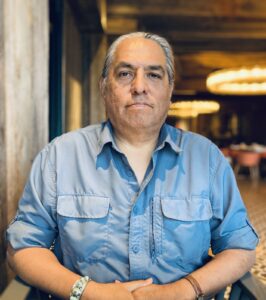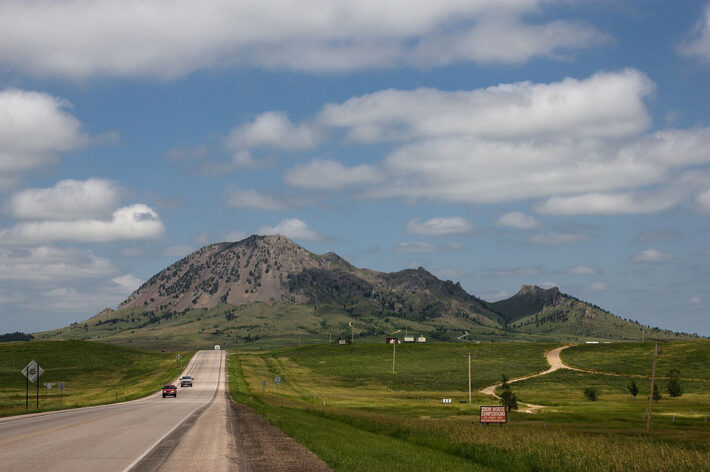
Rev. Canon Robert Two Bulls is a member of the Oglala Lakota and the Missioner for The Department of Indian Work for the Episcopal Church in Minnesota.
A member of a family with deep roots in artistry, activism, and Episcopal ministry, Two Bulls and his colleagues will be leading participants on our first Trip of Perspective to Red Shirt Table on the Pine Ridge Reservation in South Dakota this June. In this interview, we discuss how this trip is unique for the Red Shirt community and how it might inspire participants and others.
Brittany Wilmes, Faith and Money Network: What will participants experience on this Trip of Perspective?
Robert Two Bulls: It seems to be that this is more of a fact-finding experience. We’re not going to be doing as much hands-on work as groups who have visited in the past, but lots of learning and listening. We’ll be visiting sacred sites in the area and attending the community pow wow.
Wilmes: You have a long history of welcoming visitors. How long have groups been coming to visit Red Shirt?
Two Bulls: Church groups have been coming to Red Shirt since I was a little kid — maybe 1970, but it could have been earlier. My dad was an Episcopal priest, and he led a lot of groups. In fact, they used to do a trail ride, where visitors would ride horses through the Badlands.
We also have a history of youth groups coming from Episcopal dioceses from Colorado, West Virginia and other states. When I was a young kid in the 70s viewing these high schoolers coming to Red Shirt, they seemed like hippie kids coming from faraway lands.
Many Catholic groups have come through, too, as well as Seventh Day Adventists and AmeriCorps VISTA volunteers.
Red Shirt is a corner of the reservation that, if you look on a map, could be easily isolated from the rest of the reservation. The township of Pine Ridge — which contains the tribal headquarters, the hospital and small businesses — is where people go to have business done. The community was established in the early 1900s, and it would take a long time to get to Red Shirt on horseback. It’s even a long distance when driving. Nowadays, people from the tribe are always driving by Red Shirt to get to Rapid City or other more developed places, so it’s kind of an isolated community.
Wilmes: And so what draws visitors to Red Shirt specifically?
Two Bulls: I’ve been leading this project since 2000, and my focus has always been inviting visitors to help with some form of economic development. We’ve done small things, like we built a pow wow arbor with work groups and volunteers helping. The hope is that the community will take over the maintenance of these structures and utilize them. Pow wows are a small form of economic development — they help the community get recognized by the rest of the tribe.
Wilmes: I understand you took a break over the pandemic. What does it look like now to work with visiting groups?
Two Bulls: Yeah, COVID really took the wind out of everything. For a long time prior to 2020, I partnered with an Episcopal colleague who lives in Los Angeles. He would form a pilgrimage, gathering high school kids and driving from LA to South Dakota while practicing Gospel-based discipleship along the way. By the time they arrived, they were ready to work.
We don’t know quite what this next evolution will look like yet.
Wilmes: This must take so much effort to plan and accommodate visitors. Why are you and your colleagues willing to invest the time and energy in having folks come to Red Shirt?
Two Bulls: The hope is that visitors can lend their expertise or knowledge to the project, community or the tribe. We’re still in the planning stage, because we had to toss aside our old model.
Wilmes: It sounds like there’s a lot still taking shape, but what do you hope that people learn from this experience?
Two Bulls: There’s a rich culture here, and we want to increase awareness about the Lakota culture and the Oglalas more specifically. We want visitors to learn about the region and about the Episcopal church’s mission and involvement in the area. [Ed note: The Oglala are a subtribe of the Lakota people. A majority of Oglala live on the Pine Ridge Reservation, which is the eighth-largest Native American reservation in the U.S.]
We’ll be traveling to the Black Hills and learning about the different denominations that have been there throughout time. It’s a sacred site — it’s central to the whole cosmology of the Lakota spiritual realm. A lot of ceremonies are centered around Wind Cave in the Black Hills. We’ll see Bear Butte, which sits just north of the hills. It’s an extinct volcano that looks like a sleeping bear. People used to go up there and pray and fast on vision quests.

There are various points around the Black Hills that are part of the spiritual journey and experience for Oglala Lakota. We’ll experience the reservation life and visit Red Cloud School, where the mission church is. We’ll also engage with local artists and see the annual art show that goes through the summer.
The trip will end with the Red Shirt pow wow, which is very traditional. There isn’t electricity set up there, so we use power generators and shut it down by nightfall.
Wilmes: What is your prayer for how people will be changed by the experience?
Two Bulls: With the Red Shirt Project, the hope was that people could form relations with folks from the community. That could look like helping somebody develop a building structure, planning a garden, making a donation to the pow wow. Although our trip structure is changing, the essence remains the same.
It’s about using our gifts to help a community that in some ways is living outside the market economy. How can we help a community such as Red Shirt do some form of economic development that’s culturally appropriate and Gospel-based?
The 2024 Trip of Perspective to Red Shirt Table is full, but you can email us to join the wait list and learn more about our trip plans for 2025.
Curious to learn more about the Lakota people? Check out Lakota Nation vs. United States [Hulu, YouTube, Amazon Prime, Apple TV, etc.]